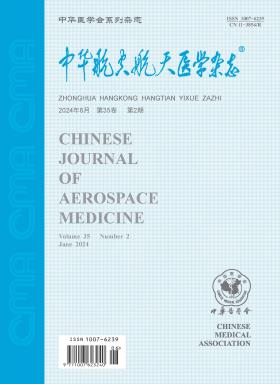海军飞行员高脂血症与代谢性疾病的相关性分析
引用次数: 0
摘要
目的调查海军转制高性能战斗机飞行员血脂水平及血脂异常分类,分析其与高尿酸血症(HUA)、脂肪肝及体质指数(BMI)超标的相关性,为飞行员健康维护提供依据。方法对128名海军高性能战斗机飞行员的血脂资料进行回顾性分析。按血脂水平分为高脂血症组和正脂症组。比较各组高尿酸血症、脂肪肝、BMI超标的发病率。结果所选飞行员高脂血症占23.44%(30/128),其中高甘油三酯血症(HTG)、高胆固醇血症、低高密度脂蛋白胆固醇血症(hdl - c)和合并高脂血症(CHL)分别占14.06%(18/128)、7.03%(9/128)、1.56%(2/128)和0.78%(1/128)。高脂血症组BMI超标的占70.00%(21/30),脂肪肝的占63.33%(19/30),显著高于正脂症组(χ2=15.755, 39.409, P 0.05)。结论海军飞行员高脂血症发病率较高,与BMI超标、脂肪肝密切相关。建议加强对海军转运飞行员高脂血症的预防,并在必要时进行干预,以延长飞行员的职业生涯,确保飞行安全。关键词:高脂血症;身体质量指数;脂肪肝;高尿酸血;飞行员本文章由计算机程序翻译,如有差异,请以英文原文为准。
Correlation analysis of hyperlipemia and metabolic diseases for navy pilots
Objective
To make a survey on blood lipid levels and blood lipid abnormality classification of the navy pilots who transit to high performance fighter, to analyze the correlation to hyperuricemia (HUA), fatty liver and body mass index (BMI) excess, and to provide the basis for pilot health maintenance.
Methods
The blood lipid data of 128 navy pilots who transit to high performance fighter were retrospectively analyzed. Pilots were divided into hyperlipidemia and ortholiposis groups by blood fat level. The morbilities of hyperuricemia, fatty liver and BMI excess were compared between groups.
Results
In selected pilots, hyperlipidemia was accounted for 23.44% (30/128), in which hypertriglyceridemia (HTG), hypercholesteremia, low high-density lipoprotein cholesterolemia (LHDL-C) and combined hyperlipidemia (CHL) was respectively accounted for 14.06% (18/128), 7.03% (9/128), 1.56% (2/128) and 0.78% (1/128). In hyperlipidemia group, 70.00% pilots (21/30) showed BMI excess and 63.33% pilots (19/30) were diagnosed as fatty liver, those were significantly higher than that of ortholiposis group (χ2=15.755, 39.409, P 0.05).
Conclusions
The morbility of hyperlipidemia in the navy pilots is high and closely correlated with BMI excess and fatty liver. It's suggested to strengthen the prevention of hyperlipidemia in navy transit pilots and to validate intervention as necessary in order to prolong pilot's career and ensure flight safety.
Key words:
Hyperlipidemia; Body mass index; Fatty liver; Hyperuricemia; Pilots
求助全文
通过发布文献求助,成功后即可免费获取论文全文。
去求助
来源期刊

中华航空航天医学杂志
航空航天医学
自引率
0.00%
发文量
2962
期刊介绍:
The aim of Chinese Journal of Aerospace Medicine is to combine theory and practice, improve and popularize, actively advocate a hundred flowers bloom and a hundred schools of thought contend, advocate seeking truth from facts, promote the development of the related disciplines of aerospace medicine and human efficiency, and promote the exchange and penetration of aerospace medicine and human efficiency with other biomedical and engineering specialties.
Topics of interest for Chinese Journal of Aerospace Medicine include:
-The content of the journal belongs to the discipline of special medicine and military medicine, with the characteristics of multidisciplinary synthesis and cross-penetration, and mainly reflected in the aerospace industry, aerospace flight safety and efficiency, as well as the synthesis of special medicine, preventive medicine, environmental medicine, psychology, etc.
-Military aeromedicine (Air Force, Navy and Army aeromedicine) and civil aeromedicine, with a balance of aerospace medicine are the strengths of the journal.
-The change in aerospace medicine from a focus on promoting physiological compensatory adaptations to enhancing human performance under extreme environmental conditions is what the journal is helping to promote.
-The expansion of manuscripts in high altitude medicine is also a special emphasis of the journal.
 求助内容:
求助内容: 应助结果提醒方式:
应助结果提醒方式:


